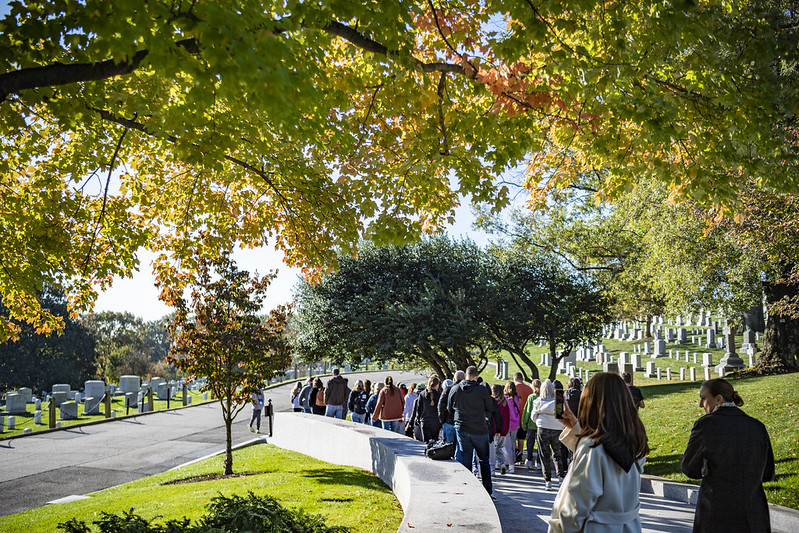
Charged with the stewardship of over 9,800 trees, Army National Military Cemeteries (ANMC) expert horticulturalists are more than caretakers; they are guardians of living history. Every spring and fall, ANMC’s horticulture team offer a series of free public walking tours, allowing visitors to enjoy the cemetery’s natural beauty while learning about the history and ongoing care of this memorial landscape.
On Oct. 24, 2025, more than 40 visitors walked beneath the vibrant red, orange, yellow and russet fall leaves on a Memorial Arboretum tour. As they meandered throughout the cemetery’s rolling hills, Urban Forester Greg Huse told stories about some of Arlington National Cemetery’s (ANC) historic trees, as well as discussing the cemetery’s extensive horticulture program.
ANC qualifies as a Level III Certified Arboretum—a status maintained by only 48 institutions worldwide. The cemetery’s variety and number of trees, combined with the horticulture team’s continued maintenance, robust record-keeping, public outreach and professional collaborations, have enabled it to retain Level III status since 2018. Emphasizing ANMC’s dedication to the horticulture profession and community, Huse explained, “We collaborate with other agencies and organizations to monitor different insects and plant species, as well as conduct trials and help them with their research.”
Highlights of the tour included one of the oldest trees in the cemetery, a white oak that predates the Civil War and the establishment of the cemetery; a progeny of the native American sycamore that still stands at the Battle of Antietam’s famous Burnside Bridge; and a large native pin oak that sequesters about 1,400 pounds of atmospheric carbon and intercepts about 23,000 gallons of storm water every year—exemplifying the importance of older trees.
Huse also pointed out a unique hybrid chestnut tree in Section 31, created by the American Chestnut Foundation by crossbreeding the native American chestnut with the Chinese chestnut. This crossbreeding enables the tree to survive diseases such as the chestnut blight that ravaged the country’s chestnut population during the first half of the 20th century. Huse closely monitors the tree’s health to ensure it continues to thrive, free of diseases.
After explaining the science of crossbreeding trees, Huse turned to memorial trees, living memorials that commemorate specific military groups, campaigns or wars. The Vietnam Helicopter Pilot and Crewman Monument and Memorial Tree, dedicated in 2015, is the most recent addition to the cemetery’s 143 memorial trees.
At President John F. Kennedy’s gravesite, Huse discussed a large native oak tree that the memorial designers incorporated into their plans, earning it the nickname, “The Arlington Oak.” When the oak toppled during Hurricane Irene in 2011, American Forests, a nonprofit conservation organization which had collected the tree’s acorns over the years, provided acorns to ANC in order to create a progeny. Pointing at three trees that were grown from the oak, Huse said, “We have that legacy of the Arlington Oak here at the Kennedy site.”
Tour attendees left with a deeper appreciation for the cemetery’s grounds. “I enjoyed learning not only about our history, but about the care of the trees and the native plants,” said Elizabeth Darlington from Washington, D.C. Patricia Murch, from Tucson, Arizona, called the cemetery majestic. “We don't have these kinds of trees where I’m from, and these are just beautiful,” she added. Katheryn Setchell, a landscape architect from Arlington, was impressed to see such care devoted to the cemetery’s trees. “Each one of these trees is a living memorial,” she observed, “and that’s amazing.”